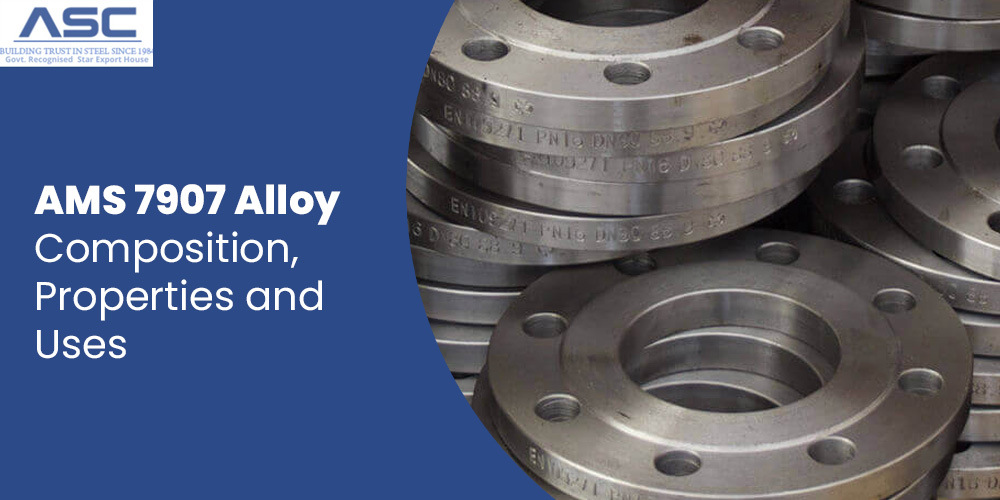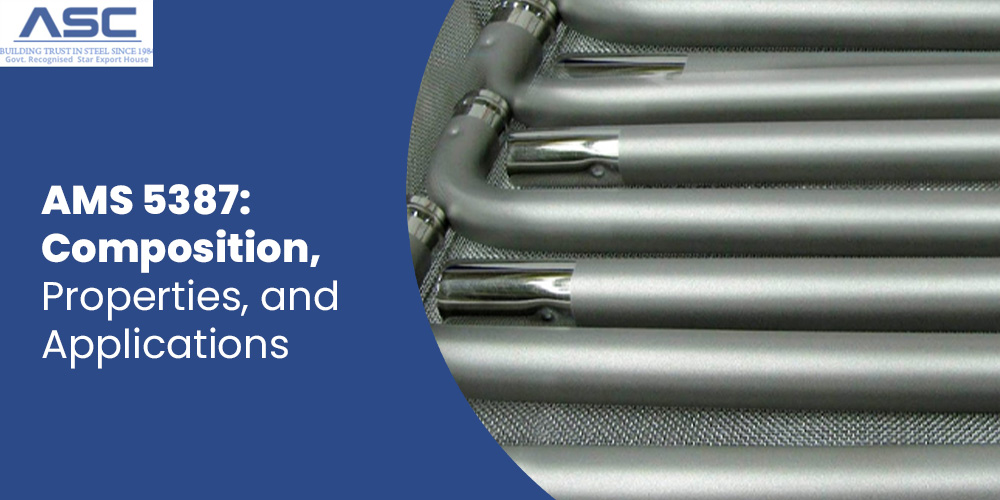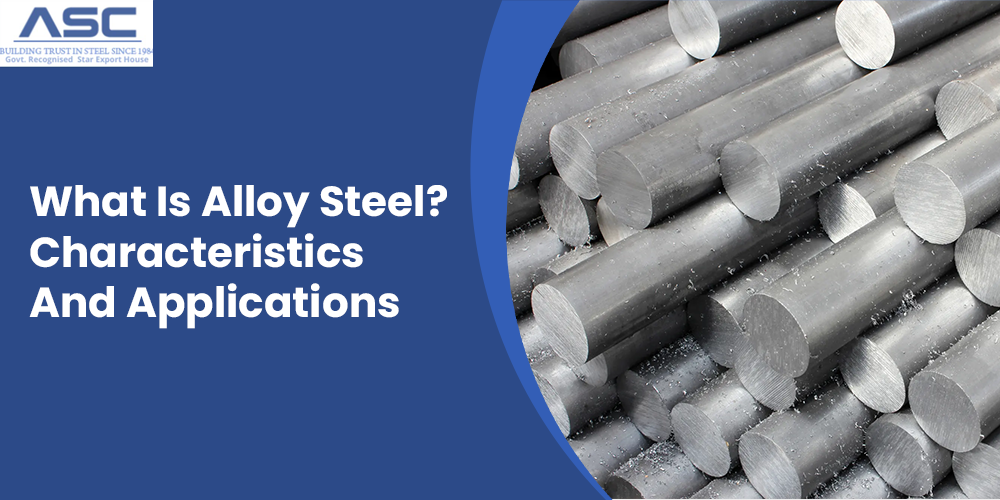Super Duplex 2507 Stainless Steel - Chemical Compositions, Properties & Uses
by AMC
Posted on June 20, 2024 at 01:00 PM

Duplex 2507 is a super duplex stainless steel designed for applications that require high strength and resistance to corrosion. It contains 25% chromium, 4% molybdenum, and 7% nickel. The high amounts of molybdenum, chromium, and nitrogen make it highly resistant to chloride pitting and crevice corrosion. The duplex structure also gives it strong resistance to chloride stress corrosion cracking.
Duplex 2507 should be used in applications below 600° F (316° C). Prolonged exposure to high temperatures can reduce its toughness and corrosion resistance.
This stainless steel has impressive mechanical properties. A thinner gauge of Duplex 2507 can often provide the same strength as a thicker nickel alloy, leading to significant weight savings and lower fabrication costs.
In this article, we’ll explore Duplex 2507 stainless steel, covering its uses, composition, characteristics, and properties.
What Is Duplex 2507 Stainless Steel?
Duplex 2507 stainless steel is a super duplex alloy characterized by its low carbon content (up to 0.03%), high chromium (~25%), nickel (~7%), and molybdenum (~4%). It is specifically designed to excel in applications requiring exceptional strength and corrosion resistance. These applications often include equipment used in chemical processing, petrochemical industries, and environments exposed to seawater.
This steel is renowned for its superior resistance to chloride-induced stress corrosion cracking. Its elevated levels of chromium, molybdenum, and nitrogen provide robust protection against pitting, crevice corrosion, and other forms of general corrosion.
Manufacturing Process of Duplex 2507 Stainless Steel
Duplex 2507 stainless steel is manufactured using a rigorous process similar to other advanced high-alloy steels. Here’s an overview of its production:
- Melting and Alloy Addition: Scrap steel along with specified alloy elements are melted in an electric arc furnace.
- Argon Oxygen Decarburization (AOD): The molten steel undergoes AOD refining, which involves processes like decarburization, sulfur refining, and degassing to enhance purity.
- Nitrogen Introduction: Nitrogen is typically added during the AOD process to optimize the steel’s properties.
- Ladle Furnace Treatment: Further adjustments are made to refine the steel’s composition and control inclusions.
- Casting: The molten steel is cast into solid forms such as ingots or continuous blooms.
- Hot Working or Cold Forming: Depending on the desired product, Duplex 2507 can be hot formed at temperatures between approximately 1024 °C and 1232 °C. For cold forming processes like bending, deep drawing, and pressing, subsequent heat treatment is necessary.
- Solution Annealing: To achieve uniform internal structure and reduce residual stresses, the steel undergoes solution annealing at temperatures around 1052-1125 °C, followed by rapid water quenching.
- Final Processing: The steel is then shaped through forging or rolling to achieve the desired dimensions and properties.
Differences Between Duplex 2507 Stainless Steel and Other Duplex Steels
Duplex 2507 stainless steel is categorized as a super duplex stainless steel, which sets it apart from other types of duplex steels. Here are the key distinctions:
1. Microstructure and Composition
- Duplex 2507 has a microstructure comprising approximately equal parts of ferrite and austenite, which is characteristic of duplex stainless steels.
- It contains high levels of chromium (~25%), molybdenum (~4%), and nickel (~7%), along with low carbon content (up to 0.03%).
2. Corrosion Resistance
- Super duplex stainless steels like Duplex 2507 are engineered to offer exceptional resistance to various forms of corrosion, including chloride-induced stress corrosion cracking, pitting, and crevice corrosion.
- While other duplex steel grades also provide good corrosion resistance, the specific alloy composition and PREN (Pitting Resistance Equivalent Number) of each grade determine the exact level of protection against corrosion.
3. Classification and PREN
- Duplex stainless steels are classified based on their PREN range, which correlates with their resistance to pitting corrosion.
- Super duplex stainless steels, including Duplex 2507, typically have a higher PREN number (ranging from 38 to 45), indicating superior corrosion resistance compared to standard duplex steels.
4. Applications
- Duplex 2507 stainless steel is preferred in applications requiring high strength and corrosion resistance, such as chemical processing equipment, offshore and marine environments, and oil and gas industries.
- Other duplex steel grades may be used in similar applications but with varying levels of performance depending on their specific alloy composition
Super Duplex 2507 Steel Chemical Composition
| Element | Content (%) |
|---|---|
| Chromium, Cr | 24 – 26 |
| Nickel, Ni | 6 – 8 |
| Molybdenum, Mo | 3 – 5 |
| Manganese, Mn | 1.20 max |
| Silicon, Si | 0.80 max |
| Copper, Cu | 0.50 max |
| Nitrogen, N | 0.24 – 0.32 |
| Phosphorous, P | 0.035 max |
| Carbon, C | 0.030 max |
| Sulfur, S | 0.020 max |
| Iron, Fe | Balance |
Physical Properties of Stainless Steel Grade Super Duplex 2507
| Properties | Metric | Imperial |
|---|---|---|
| Density | 7.8 g/cm3 | 0.281 lb/in3 |
| Melting point | 1350°C | 2460°F |
Super Duplex 2507 Steel Mechanical Properties
| 0.2% Offset Yield Strength, ksi | 80 min. |
| Ultimate Tensile Strength, ksi | 116 min. |
| 1% Offset Yield Strength, ksi | 91 min. |
| Elongation in 2 inches, % | 15 min. |
| Hardness, Rockwell C | 32 max |
| Impact Energy, ft-lbs | 74 min. |
Equivalents Grade of Duplex 2507 Stainless Steel
| Grade | UNS No. | Euronorm No. | Euronorm Name |
|---|---|---|---|
| 2507 | S32750 | 1.441 | X2CrNiMoN25-7-4 |
Uses of Duplex 2507 Stainless Steel
Duplex 2507 stainless steel is utilized across various industries for its exceptional strength and corrosion resistance. Some common applications include:
- Used in desalination plants due to its resistance to chloride-induced corrosion.
- Offshore platforms, pipelines, and subsea equipment benefit from its durability in harsh marine environments.
- Equipment handling corrosive chemicals and acids.
- Reactors, vessels, and tanks used in chemical manufacturing.
- Bleaching equipment where resistance to chemicals and high temperatures is crucial.
- Applications such as PVC strippers and reactors.
- Components exposed to seawater and brine solutions.
- Flue gas desulfurization (FGD) systems where resistance to sulfur compounds is required.
- Ship propellers, shafts, and fittings subject to marine environments.
- Scrubbers and exhaust systems in industrial facilities.
- Essential for fluid handling in pipelines and systems, including elbows, tees, stub-ends, reducers, and pipe nipples.
ASTM Specifications
| Pipe Smls | Pipe Welded | Tube Smls | Tube Welded | Sheet/Plate | Bar | Flanges & Fittings |
|---|---|---|---|---|---|---|
| A790 | A790 | A789 | A789 | A240 | A276 | A182 |
Machinability, Magnetism, and Weldability of Duplex 2507 Stainless Steel
1. Machinability
Duplex 2507 stainless steel falls within a machinability range of 10 to 30%, indicating it is relatively challenging to machine. Achieving desired results requires specialized tooling, increased cutting force, and slower machining speeds compared to materials with higher machinability ratings.
2. Magnetic Properties
Yes, Duplex 2507 stainless steel exhibits magnetic properties due to the presence of ferritic grains in its microstructure.
3. Weldability
Duplex 2507 stainless steel is weldable and can be effectively joined using various welding methods:
- SMAW (Shielded Metal Arc Welding)
- PAW (Plasma Arc Welding)
- GTAW (Gas Tungsten Arc Welding)
- FCW (Flux Cored Wire)
- SAW (Submerged Arc Welding)
When welding Duplex 2507:
- Use 2507/P100 filler metal for optimal results.
- Preheating is generally not necessary unless specified.
- Maintain an interpass weld temperature below 100°C to prevent compromising weld integrity.
Does Duplex 2507 Stainless Steel Rust?
Duplex 2507 stainless steel has excellent corrosion resistance, but it can still rust under extreme conditions. Compared to other types of stainless steel, however, it is less prone to rusting. The high levels of chromium and molybdenum in Duplex 2507 provide exceptional resistance against uniform corrosion induced by organic acids like formic and acetic acid.
In practical terms, Duplex 2507 steel maintains its integrity and resists corrosion in environments with corrosive substances such as seawater, acids, and chemicals. It is designed to withstand these conditions without easily rusting or corroding, making it suitable for applications where robust corrosion resistance is essential. However, like all metals, prolonged exposure to extreme conditions can still lead to rusting or corrosion over time. Regular maintenance and appropriate environmental controls are crucial to maximize the longevity of Duplex 2507 stainless steel components.
Common Forms of Duplex 2507 Stainless Steel Material
Duplex 2507 stainless steel is available in several common forms, each tailored to specific industrial applications:
- Sheet: Duplex 2507 stainless steel sheets are versatile and used in construction, manufacturing, and marine industries. They are suitable for applications requiring corrosion resistance and structural integrity.
- Plate: Duplex 2507 stainless steel plates are ideal for projects needing larger, thicker sections of the alloy. They are used in pressure vessels, tanks, and structural components where strength and durability are crucial.
- Bar: Duplex 2507 stainless steel bars come in various shapes and sizes, including round, square, and hexagonal. They are used for machining components like shafts, valves, and fasteners, offering flexibility and robustness.
- Pipe & Tube (Welded & Seamless): Duplex 2507 stainless steel pipes and tubes are manufactured in both welded and seamless forms. They are extensively used in industries such as oil and gas, chemical processing, and desalination due to their corrosion resistance and reliability in harsh environments.
- Weld Wire: Duplex 2507 stainless steel weld wire is designed for welding and joining applications. It ensures the strength and corrosion resistance of the alloy in critical structural and repair work, maintaining integrity under high-stress conditions.
Advantages of Using Duplex 2507 Stainless Steel
Duplex 2507 stainless steel offers several advantages that make it a preferred choice in various industries:
- High Corrosion Resistance: Duplex 2507 has a high Pitting Resistance Equivalent Number (PREN) of up to 43, indicating superior resistance to pitting corrosion compared to stainless steel grades like 254SMO.It also demonstrates exceptional resistance to other forms of corrosion, including Stress Corrosion Cracking (SCC), crevice corrosion, and general corrosion.These combined corrosion-resistant properties make Duplex 2507 suitable for aggressive environments such as chemical processing, oil and gas, and marine applications.
- High Strength: Duplex 2507 offers double the yield strength of 300 series stainless steel grades. This strength advantage allows for the use of thinner steel sections without compromising structural integrity, leading to reduced material costs and lighter equipment under the same load conditions.
- Improved Wear Resistance: With double the yield strength and tensile strength of ordinary stainless steel, Duplex 2507 exhibits significantly improved wear resistance. It can withstand higher mechanical stresses and abrasive conditions, making it suitable for applications where durability and longevity are critical.
- Versatility and Reliability: The combination of high strength and corrosion resistance makes Duplex 2507 a versatile and reliable choice across a wide range of industries. It is used in applications such as desalination plants, chemical processing equipment, offshore platforms, and structural components where performance under demanding conditions is essential.
Is Duplex 2507 Stainless Steel Better Than Regular Stainless Steel?
Choosing between Duplex 2507 stainless steel and regular stainless steel (such as 304 or 316) depends on specific application requirements. Here's a comparison to help determine which is better suited:
Duplex 2507 Stainless Steel
Advantages:
- Exceptional Corrosion Resistance: Superior resistance to corrosion in aggressive environments rich in chlorides, including pitting, crevice corrosion, and stress corrosion cracking.
- High Strength: Approximately double the yield strength of austenitic stainless steels like 304 and 316, allowing for thinner material usage and reduced costs.
- Versatility: Suitable for a wide range of applications in chemical processing, oil and gas, desalination, and marine environments where durability and corrosion resistance are crucial.
- Longevity: Offers prolonged service life and reduced maintenance costs due to its robust resistance to corrosion.
Considerations:
- Cost: Generally more expensive than regular stainless steel grades due to higher alloy content.
- Welding Challenges: Requires more care and expertise during welding compared to austenitic stainless steels, potentially increasing fabrication costs.
- Temperature Limitations: Limited in terms of high-temperature applications above 600°F (316°C).
Regular Stainless Steel (e.g., 304 or 316)
Advantages:
- Ease of Welding: Easier to weld and fabricate, reducing labor costs and complexity during manufacturing.
- Cost-Effective: Generally more affordable due to lower alloy content.
- Wider Temperature Range: Can withstand higher temperatures compared to Duplex 2507.
Considerations:
- Corrosion Resistance: While good in many environments, regular stainless steels may not offer the same level of corrosion resistance as Duplex 2507 in highly corrosive conditions rich in chlorides.
- Strength: Lower yield strength compared to Duplex 2507, which may necessitate the use of thicker material in some applications.
Is Duplex 2507 Stainless Steel Expensive?
Yes, Duplex 2507 stainless steel is considered expensive compared to regular stainless steel grades like 304 or 316. The higher cost of Duplex 2507 primarily stems from its elevated alloying content, which includes significant amounts of chromium, molybdenum, and nickel. These alloying elements contribute to its exceptional corrosion resistance properties, particularly in harsh and corrosive environments rich in chlorides.
What Is the Difference Between Duplex 2507 Stainless Steel and Super Duplex Steel?
Duplex 2507 stainless steel and super duplex steel are both categorized within the duplex stainless steel family, distinguished primarily by their composition, corrosion resistance, and mechanical properties:
Duplex 2507 Stainless Steel
- Composition: Duplex 2507 stainless steel typically contains about 25% chromium, 7% nickel, 4% molybdenum, and significant levels of nitrogen.
- Microstructure: It has a dual-phase microstructure consisting of roughly equal proportions of ferrite and austenite phases.
- PREN Number: Duplex 2507 usually has a PREN (Pitting Resistance Equivalent Number) in the range of 38-45, indicating excellent resistance to pitting corrosion.
- Applications: Widely used in industries such as oil and gas, chemical processing, desalination, and marine environments where high strength and superior corrosion resistance are required.
Super Duplex Steel
- Composition: Super duplex stainless steels, like other super duplex grades, contain higher levels of chromium, molybdenum, and nitrogen compared to Duplex 2507.
- Microstructure: They also feature a dual-phase microstructure with a balanced proportion of ferrite and austenite phases, similar to Duplex 2507.
- PREN Number: Super duplex steels typically have PREN numbers ranging from 40 to 45 or higher, indicating even greater resistance to corrosion compared to duplex grades like 2507.
- Applications: Suitable for extremely demanding environments where exceptional corrosion resistance is critical, such as in offshore and subsea applications, chemical processing involving aggressive chemicals, and high chloride environments.
What Is the Difference Between Duplex 2507 Stainless Steel and Duplex 2205?
The main differences between Duplex 2507 stainless steel and Duplex 2205 are primarily in their composition, corrosion resistance, and mechanical properties:
Chemical Composition
- Duplex 2205:
- Contains approximately 22% chromium, 5-6% nickel, 3% molybdenum, and 0.15-0.20% nitrogen.
- Classified as a duplex stainless steel with a balanced ferrite-austenite microstructure.
- Duplex 2507:
- Contains about 25% chromium, 7% nickel, 4% molybdenum, and significantly higher levels of nitrogen compared to 2205.
- Classified as a super duplex stainless steel due to its higher alloy content and superior corrosion resistance properties.
Corrosion Resistance
- Duplex 2205:
- Offers good resistance to localized corrosion such as pitting and crevice corrosion.
- Suitable for a wide range of environments, including marine and chloride-rich environments.
- Duplex 2507:
- Provides enhanced resistance to corrosion, particularly in aggressive environments with high chloride content.
- Superior resistance to pitting and crevice corrosion compared to Duplex 2205, attributed to its higher molybdenum and nitrogen content.
Mechanical Properties
- Duplex 2205:
- Lower yield strength and tensile strength compared to Duplex 2507.
- Higher ductility and better formability, making it easier to work with in certain applications.
- Duplex 2507:
- Higher yield strength, tensile strength, and impact toughness compared to Duplex 2205.
- Reduced ductility compared to 2205, which may limit some forming and fabrication processes.
Applications
- Duplex 2205:
- Widely used in applications where moderate strength and good corrosion resistance are required, such as chemical processing, oil and gas exploration, and marine environments.
- Duplex 2507:
- Preferred for applications demanding superior corrosion resistance and high strength, such as offshore platforms, desalination plants, chemical processing equipment handling aggressive chemicals, and marine applications in harsh environments.
Summary
This article has provided an overview of Duplex 2507 stainless steel, detailing its composition, properties, and diverse applications. Known for its superior corrosion resistance and high strength, Duplex 2507 is favored in demanding environments such as offshore platforms, chemical processing equipment, and marine applications. Its alloy composition, including high levels of chromium, nickel, molybdenum, and nitrogen, contributes to its exceptional performance against pitting, crevice corrosion, and stress corrosion cracking. For further information on Duplex 2507 steel and its applications, readers are encouraged to reach out to a Amardeep Steel representative.

AMS 7907 Alloy - Composition, Properties and Uses
If you work in the aerospace or defense industry, you've likely come across AMS 7907. This material finds common usage in the manufacture of high-performance engine components, bearings, and turbine blades.

